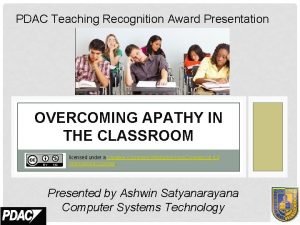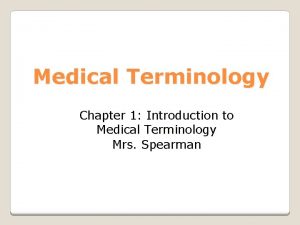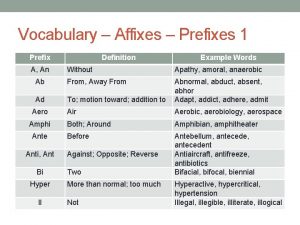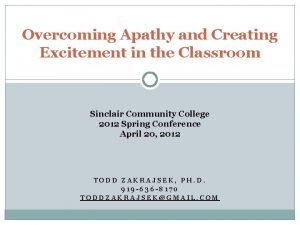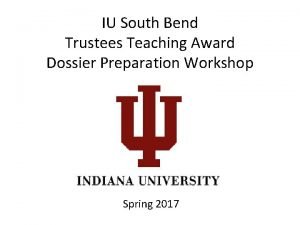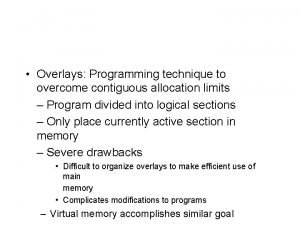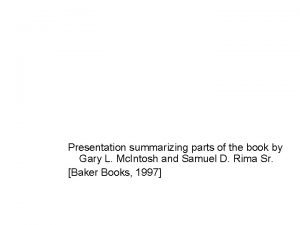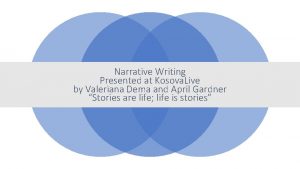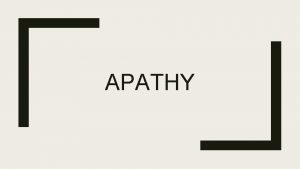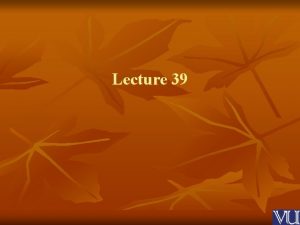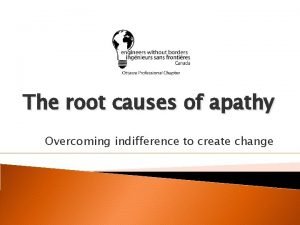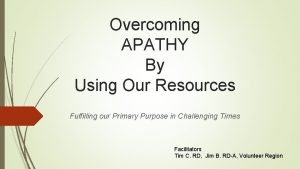PDAC Teaching Recognition Award Presentation OVERCOMING APATHY IN























- Slides: 23

PDAC Teaching Recognition Award Presentation OVERCOMING APATHY IN THE CLASSROOM licensed under a Creative Commons Attribution-Non. Commercial 4. 0 International License. Presented by Ashwin Satyanarayana Computer Systems Technology

FIRST LESSON I LEARNT • “sage on the stage” Collaborate 10% Communicate Creative • Be a “guide on the side” Not attentive 40% of the time • Teacher centered -> Student centered • Teacher centered transmission (Old Style) to Collaboration oriented creation (New Style) Critical thinking

SECOND LESSON: THREE LOVES OF TEACHING • Love of learning • Love of learners • And love of bringing the first two loves together

LEARNING STYLES: THEN AND NOW Confucius (400 BC): • What I hear, I forget. • What I see, I remember. • What I do, I understand. Silberman (1996): • What I hear, I forget. • What I hear and see, I remember a little. • What I hear, see, and ask questions about or discuss with someone else, I begin to understand. • What I hear, see, discuss and do, I acquire knowledge and skill. • What I teach to another, I master.

LEARNING IMPROVED WHEN STUDENTS ASKED TO DO SOMETHING WITH THE INFORMATION What do you do in your class to engage students after you have taught new material? • Partner discussions – up to two letter grade improvement • State the information in their own words • Give examples of it • Recognize it in various guises and circumstances • See connections between it and other ideas • Make use of it in various ways Silberman (Active Learning; 1996)

HOW WE LEARN Higher Order Thinking Skills BLOOM’S TAXONOMY ”ZONE OF DEEPER LEARNING” Lower Order Thinking Skills Source: David Bloom

LEARNING STYLES AND TEACHING STYLES Index of Learning Styles Sample Question: I understand something better after I: a. Try it out b. Think it through Learning Style: Active processing Teaching Style: Student Participation

TYPES OF LEARNING? LEARNER-CENTERED-TEACHING • Active learning, in which students solve problems, answer questions, formulate questions of their own, discuss, explain, debate, or brainstorm during class • Cooperative learning, in which students work in teams on problems and projects under conditions that assure both positive interdependence and individual accountability • Inductive teaching and learning, in which students are first presented with challenges. Inductive methods include inquiry-based learning, case-based instruction, problem-based learning, projectbased learning, discovery learning, place-based-learning and gamebased-learning.

WHY LEARNER-CENTERED-APPROACH? • Brain does not function as audio or visual tape recorder. • Incoming information is being processed; i. e. , the brain is asking questions: • Have I heard or seen this information before? • Where does this information fit in? What can I do with it? • Can I assume that this is the same idea that I had yesterday or last month? • Active classrooms give opportunities for information to be better processed Silberman (Active Learning; 1996)

HOW: INTEGRATING ACTIVE LEARNING 50 Minute Lecture 5 Minute Thinking or Reflection Activity Introduce New Topic or Revisit Previous Topic 10 -15 Minutes Group Discussion or Application Activity 10 -15 Minutes Introduce New Topic 10 -15 Minutes 5 Minute Reflection Activity 75 Minute Lecture: In. Depth Group Activity 15 -20 Minutes

STRATEGY Ask Before You Tell Think-Pair-Share Note taking pairs Jigsaw Case Studies/Problem. Solving One-Minute Paper OUTCOME Activation of prior knowledge Explaining, Discussion, and Collaboration Peer Instruction, Evaluating, and Synthesizing Real-World Relevancy, Analyzing, and Application Reflection on the learning process

HOW: INTEGRATING ACTIVE LEARNING On your index cards, write one method that you are currently using and one method that you would like to use More Time Less Time

TEN METHODS TO GET PARTICIPATION 1. 2. Open Discussion – not simply “Are there any questions? ” Response Cards – answers to posed questions on submitted index cards (more anonymity) 3. Polling – a short survey that is passed out and tallied to focus discussion 4. Subgroup Discussions – share and record information; develop questions and promote further consideration 5. Learning Partners – work on tasks or discuss key questions with the student next to them 6. Whips – go around group and obtain short answers to key questions 7. Panels – small group of students may present views in front of entire class 8. Fishbowl – discussion circle with remainder of class listening in. 9. Gamification in the class - Games have many elements that make them powerful vehicles for human learning. 10. Calling on the Next Speaker – student view sharing and calling on next student

EX. 1: USING VISUALS EX: USING CLIPS FROM MOVIES • Ari Maller (Physics) – 1441: Introduction to Mechanics • https: //openlab. citytech. cuny. edu/amaller 1441/? page_id=96

EX 2: USING REAL WORLD EXAMPLES • Kate Poirier (Math 1275) • https: //teacher. desmos. com/activitybuilder/custom/58223 62857 c 888010651 c 601

EX. 3 – SUBGROUP DISCUSSION ON MAGIC TRICKS AND PUZZLES • A Puzzle a Day Provides Practice That Pays • Magic Tricks (CST 1100) • Newspaper trick – to teach the concept of Queues and Stacks data structures • Using card tricks

EX 4: INCORPORATING DESIGN THINKING LITTLE BITS • little. Bits is a system of electronic building blocks that snap together to turn ideas into inventions • More than just the skills to live in today’s world, kids will gain skills to invent tomorrow’s world too • https: //www. youtube. com/watch? v=YUUs. JSDa 7 PE

EX. 5 – IN CLASS REFLECTION THE ONE MINUTE PAPER – DR. ESTELA ROJAS • At the end of a class: • Students are instructed to answer the following question(s): • What is the most important topic that we covered today and why? • Of the topics that we covered today (or this week), which topic do you think you understand the best? • Which topic do you feel you understand the least or find most confusing? • What would make this material clearer to you? • Make up a question about an everyday phenomenon that can be explained using material presented in class today. • You may also ask them additional questions such as: • The pace of the course is: too fast, about right, too slow • In terms of teaching methods, the most effective for me has been: _________ • In terms of teaching methods, the least effective for me has been: _________

ACTIVITY (15 MINUTES) • Please think of an activity with your partner(s) that you can implement in your classroom to teach a concept. • Identify any concept (can be interdisciplinary) you want to teach • Create an activity using props given (pick any one) • • • Pack of cards Little bits Ball of rubber bands, Bowl of paper clips Newspaper

WORDS OF ADVICE • Develop your personal philosophy (in your teaching portfolio) as to what is important for you. • Organize your course notes • During the academic year – evolutionary • During the summer – revolutionary

RESOURCES • Books • “Learner-Centered Teaching: Five Key Changes to Practice” by Maryellen Weimer • “How Learning Works: Seven Research-Based Principles for Smart Teaching” by Susan A. Ambrose, Michael W. Bridges, Michele Di. Pietro, Marsha C. Lovett, Marie K. Norman, Richard E. Mayer (Foreword) • “Teaching at Its Best: A Research-Based Resource for College Instructors” by Linda B. Nilson (Best Seller) • “What the Best College Teachers Do” by Ken Bain (Best Seller) • “On Course: A Week-by-Week Guide to Your First Semester of College Teaching” by James M Lang • “Active Learning: 101 Strategies to Teach Any Subject”, Silberman

RESISTANCE TO ACTIVE LEARNING • Some resistance to active learning • “Just tell me the minimum I need to do” • Buy-in to individual, pair, and team exercises is highly dependent on the particular class. • Success with all levels of students; just need to find correct active learning exercises

QUESTIONS ?
 Pdac
Pdac Pre award vs post award
Pre award vs post award Occupational recognition award
Occupational recognition award Appendectomy word breakdown
Appendectomy word breakdown Etymology of apathy
Etymology of apathy Apathy
Apathy Employee apathy
Employee apathy Prefix
Prefix Apathy is the solution
Apathy is the solution Apathy word origin
Apathy word origin Apathy in a sentence
Apathy in a sentence Apathy etymology
Apathy etymology Iu trustees teaching award
Iu trustees teaching award Coalescing holes in operating system
Coalescing holes in operating system Overcoming the dark side of leadership
Overcoming the dark side of leadership Overcoming barriers to employment
Overcoming barriers to employment Scripture about overcoming adversity
Scripture about overcoming adversity Overcoming communication barriers in pharmacy
Overcoming communication barriers in pharmacy Overcoming trials and temptations
Overcoming trials and temptations Overcoming hindrances to spiritual development
Overcoming hindrances to spiritual development How did helen keller overcome adversity
How did helen keller overcome adversity Perfectionist scale
Perfectionist scale Overcoming life issues
Overcoming life issues Writing a narrative about overcoming a challenge
Writing a narrative about overcoming a challenge
